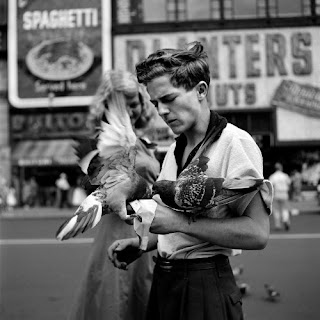Vivian Maier is arguably the most evasive and wondered shooter in the world of street photography. While not being able to find much on her educational background, there sure is plenty of information about her early life. Vivian Maier, having a French mother and an Austrian Father, was born on February 1st, 1926, in busy New York City. But despite being born American, Maier spent most of her youth across the ocean in France, where she grew up and had a close relationship with professional photographer Jeanne Bertrand. She then began to experiment with photography in 1949, and moved to the states permanently two years later in 1951 (New York). She worked as a nanny and caregiver for most of her adult life, and relocated to Chicago to tend to a new family.
Because of her job, Maier was unable to develop her photos, for the constant relocation of her office made it hard to do so. When her work was finally discovered in 2007, nearly two years before her death, they found over 100,000 negatives, and over 700 undeveloped color rolls of film. Maier was really secretive about her work, but like most big secrets, they came out into the open sooner or later. There was a film produced that is all bout her life, and her secret talent, called Finding Vivian Maier. Proceeds from the movie, along with the sales from her individual photos, all go towards the Vivian Maier Scholarship Fund which helps lift the financial and opportunity burden for female students at SAIC in Chicago.
Vivian Maier is arguably the Anne Frank of photography. When her work was found in a local thrift auction in 2007, the world was finally given a view through the eyes of Maier. No one could have been prepared for what they would find buried in Maier's monstrous collection of negatives. One thing that makes Maier's work unique is her shift on subjects and style. She started shooting in color around the time she moved to Chicago. Her work slowly steered away from people as she started shoot found objects like those in dumpsters, newspapers, and graffiti. Maier has definitely left a mark in the world of photography by setting the steps for a lot of new photographers today.
JonSeg
Thursday, March 16, 2017
Tuesday, November 29, 2016
Jonathan Segovia
Mrs. Weisberger
Photography
11/29/2016
William Eugene Smith is one of those photographers whose outstanding work may be familiar to your eye, but his background might be more of an enigma. Born in Wichita, Kansas, he took great interest in photography at the tender age of fourteen, and by the age of seventeen he started working for local newspapers. He then studied with the Irish when he received a photography scholarship to the University of Notre Dame. A scholarship that he only took advantage of for a year, for he ditched that part of his life to start working for Newsweek, while freelancing for numerous magazines including: LIFE, Collier’s, and The New York Times. These were just the stepping stones that lead to Smith’s awe-inspiring career that opened many people's eyes to things that they weren't yet fully aware of.
One of the most renowned photo essays by Smith was that of when the United States entered the second World War. He was in side by side combat with American soldiers as they fought off the Japanese. His weapon of choice was a camera, and although he didn’t shoot as many pictures as bullets, his work may have left a bigger impact on the world. He also accomplished many other photo essay’s like that of a country doctor, a midwife, and the re-election of the Labour Party candidate Clement Attlee, in Great Britain. But of all these fascinating photo essays Smith created, his last piece of work, “Minamata”, which opened the closed doors behind the victims of mercury poisoning in a small Japanese fishing village, was one of his greatest works. set the norm for photojournalism for many years after his death.
William Eugene Smith is undoubtedly one of the godfathers of photojournalism. Smith is said to have brought the photo essay to life, for his work set the norm for photojournalism for many years after his death and till this day. Smith will always be remembered, and even more with the W. Eugene Smith Memorial Fund, established in his memory after his death. The Memorial Fund financially supports numerous photographers that take the same path in photography and photojournalism as Smith did during his tremendous career. For this, Smith will always be remembered as a founding father of the photojournalism world.
Subscribe to:
Comments (Atom)











